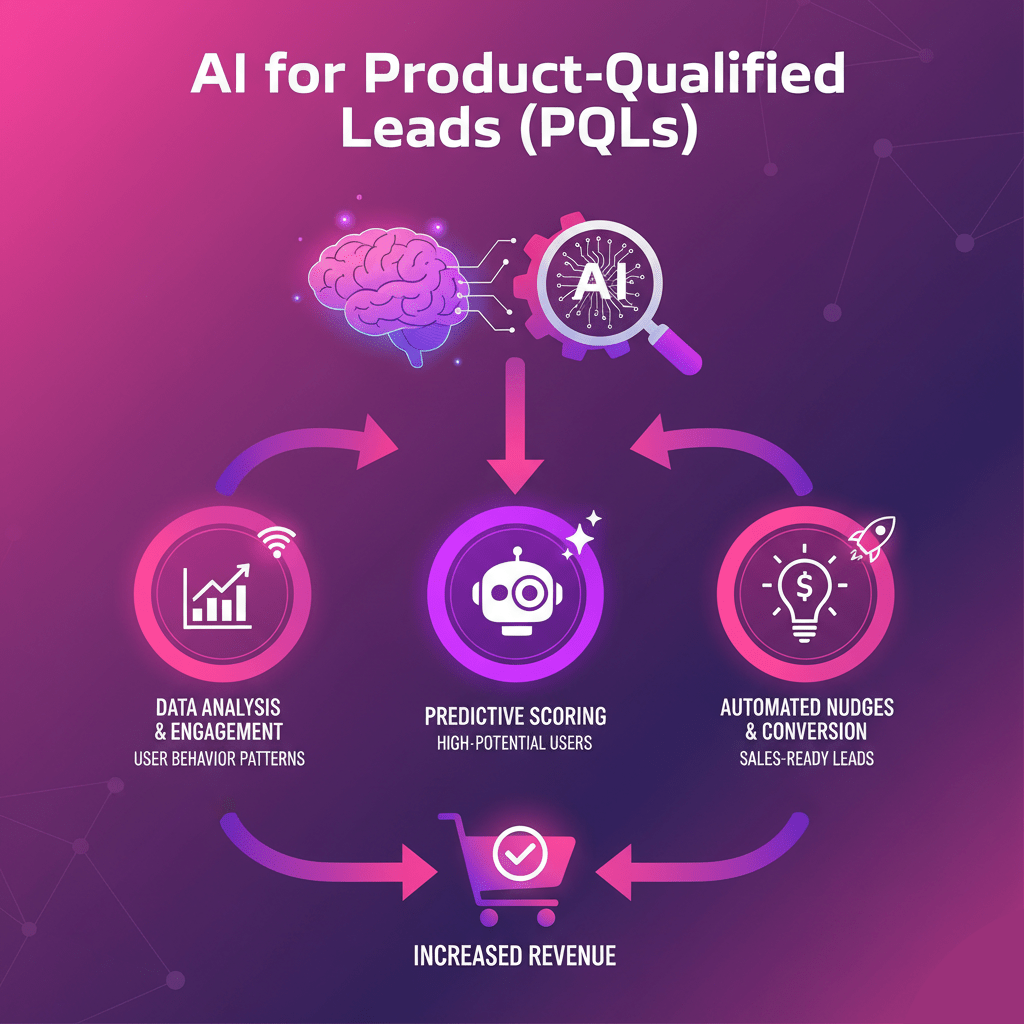“Leverage AI for Product-Qualified Leads (PQLs) to instantly call and qualify high-intent users the moment they show buying signals, accelerating conversions and revenue.”
In today’s fast-paced digital world, businesses continually seek innovative ways to boost sales and drive revenue growth. For SaaS companies, the challenge is even greater. They need to stand out in a crowded market and convert trial users into loyal, paying customers. This is where Product-Qualified Leads (PQLs) come into play. These are not just any leads; they are users who have experienced your product and shown genuine interest. They’re on the cusp of becoming paying customers. The key is to engage them quickly and effectively before their interest wanes. This guide explores how Artificial Intelligence (AI) can revolutionize your PQL conversion strategy, transforming high intent into high revenue in minutes.

The Power of Product-Qualified Leads (PQLs): Your Hottest Prospects
Imagine a prospect who has already spent time with your product. They’ve explored its features, perhaps even achieved a small win using it. They understand its value proposition, not from a marketing brochure, but from personal experience. This, my friends, is a Product-Qualified Lead (PQL). They are gold. They’re miles ahead of a Marketing-Qualified Lead (MQL) or a Sales-Qualified Lead (SQL) because they’ve already “test-driven” your solution.
PQLs are users who show clear buying signals through their actions within your product. They may have hit a usage limit, repeatedly used a premium feature, or spent a significant amount of time in a specific part of your application. These aren’t random actions; they are indicators of genuine need and potential for conversion.
Think about it: A user signs up for your free trial. They poke around, maybe complete a basic task. Then, something shifts. They start using a particular feature on a daily basis. They invite team members. They upload more data. These aren’t just trial users anymore; they are PQLs, signaling their readiness for a more profound commitment. Their product usage tells you they’re seeing value and are close to needing more.
The beauty of the product-led growth (PLG) strategy hinges on identifying these PQLs. PLG is all about letting your product be the primary driver of customer acquisition, retention, and expansion. When users experience value firsthand, they are far more likely to convert. PQLs are the natural outcome of a successful PLG motion. They represent the point at which product usage directly translates into sales opportunities.
Ignoring PQLs is like leaving money on the table. These users have already invested their time and effort. They’ve crossed the initial hurdle of adoption. They’re warm leads, practically knocking on your sales door. Your job is to open that door quickly and guide them in.
The traditional sales model often involves lengthy qualification processes. But with PQLs, a significant part of that qualification is already done by the product itself. The user’s actions speak louder than any demographic data. They’ve demonstrated through their engagement that your product meets their needs. Now, it’s about helping them make the final leap to a paid subscription.
Speed is Everything: The Vanishing Window of Opportunity
Here’s the harsh truth about PQLs: Their intent is fleeting. It’s a perishable commodity. You have a narrow window to act. The moment a user becomes a PQL, their interest is at its peak. They’ve just experienced a moment of clarity or an “aha!” moment with your product. They’re feeling the pain point your product solves, or they’re enjoying the benefit it provides. This is when they’re most receptive to a conversation about upgrading.
Wait too long, and that peak intent begins to fade. The user might get distracted by other tasks, explore competitor solutions, or simply forget the positive experience they just had. Life happens. Other priorities emerge. That burning desire to upgrade cools down.
This isn’t just anecdotal. Studies consistently show that the faster you respond to a lead, the higher your chances of conversion. For PQLs, this speed-to-lead concept is even more critical. They’re not just any leads; they’re qualified by their actions. They’ve shown you their hand. You must act decisively.
Imagine a user hitting a premium feature limit. They see the paywall. At that exact moment, their need for that feature is strong. They’re thinking, “I need this. How do I get more?” If you reach out immediately, you’re likely to catch them at the height of their decision-making process. If you wait hours or even a day, that urgency dissipates. They might find a workaround, decide they don’t need the feature as much as they thought they did, or start looking elsewhere.
The speed-to-lead for PQLs isn’t about being aggressive; it’s about being helpful and timely. It’s about recognizing their moment of need and offering a solution precisely when they’re looking for one. It’s about demonstrating that you understand their journey and are there to support their growth and development.
This is where traditional sales processes often fall short. Manual lead qualification, assigning leads, and then having a sales rep manually dial a number can take hours, even days. By then, the PQL has moved on. Their hot intent has cooled, or even turned cold. This delay translates directly into lost revenue.
The goal is to shrink that window of opportunity to mere minutes. To go from PQL trigger to active engagement in the blink of an eye. This is where AI steps in as a game-changer. It’s about leveraging technology to match the user’s intent at the speed they expect.
Introducing SalesCloser.ai: Your Ultimate PQL Conversion Engine
Now, let’s discuss how to address this speed dilemma and optimize your PQL conversions. Enter SalesCloser.ai. This platform isn’t just another sales tool; it’s a dedicated PQL conversion engine designed to act with unprecedented speed and precision. SalesCloser.ai transforms the way you engage high-intent users, turning product usage into immediate sales opportunities.
SalesCloser.ai operates on a simple, yet powerful principle: instant, intelligent engagement. It understands that when a user becomes a PQL, every second counts. Its core function is to bridge the gap between product usage and a meaningful sales conversation, automatically and effectively.
Here’s how SalesCloser.ai becomes your ultimate PQL conversion tool:
- API-Triggered Instant Action: The moment a user’s behavior triggers a PQL status within your product, SalesCloser.ai responds instantly. This isn’t a manual process. Your product, through a simple API integration, signals SalesCloser.ai. This trigger could be anything from hitting a usage limit, accessing a premium feature multiple times, spending a certain amount of time in a key module, or completing a critical task. The trigger is immediate, and so is SalesCloser.ai’s response.
- AI-Powered Outbound Calls: Within moments of the API trigger, the SalesCloser.ai agent places a call to the PQL. This isn’t a cold call. It’s a warm, highly relevant outreach based on their recent product activity. The AI is designed to sound natural, personable, and helpful. It initiates a conversation, not a script read-out.
- Intelligent Engagement and Validation: The AI agent engages the user directly about their positive product experience. It might reference the specific action that triggered the PQL status. For example, “Hi [User Name], I noticed you just spent a good amount of time in our [Specific Feature] today. How are you finding it?” This personalized approach validates their product journey and makes the conversation relevant. The AI is trained to understand and respond to user queries, ensuring a smooth and natural dialogue.
- Seamless Hand-off to Product Experts: The AI’s primary goal isn’t to close the deal itself. It’s to qualify the PQL further and offer to connect them with a human product expert. This is where the sales assist model shines. The AI agent, after a brief, positive interaction, will say something like, “Based on your interest in [Feature/Benefit], I think a quick chat with one of our product experts could really help you unlock its full potential and discuss upgrade options. Would you be open to a quick 15-minute call?” This approach respects the user’s time and focuses on providing value.
- Converting Intent into Revenue in Minutes: This entire process—from PQL trigger to an AI-initiated call, engagement, and offer to connect with an expert—happens in minutes, not hours or days. This speed is what turns fleeting intent into solid revenue. You’re catching the user when their interest is highest, their need is clearest, and their receptiveness to a conversation about upgrading is at its peak.
SalesCloser.ai acts as your always-on, always-ready PQL conversion specialist. It automates the critical initial outreach, ensuring no high-intent lead falls through the cracks due to delays. It’s about leveraging the power of AI to optimize your product-led growth strategy, making your sales process more efficient, more effective, and significantly faster.
The Mechanism: How SalesCloser.ai Works Its Magic
Understanding the underlying mechanics of SalesCloser.ai helps you grasp its true power. It’s not just a fancy chatbot; it’s a sophisticated system designed for precision engagement.
- Defining Your PQL Triggers: The first step is to clearly determine what constitutes a PQL within your product. This is crucial. What specific in-app usage triggers indicate high intent?
- Feature X Usage: The user utilizes a premium feature five times per day.
- Data Upload Threshold: User uploads more than 100 entries.
- Project Creation: User creates their third project.
- Collaboration: User invites two team members.
- Time Spent in Key Module: The User spends more than 30 minutes in your analytics dashboard.
- Trial Expiration Imminent: The user is 3 days from the trial end and is actively using the product.
- These triggers are unique to your product and your ideal customer profile. SalesCloser.ai works with your existing analytics and product telemetry.
- API Integration: The Seamless Handshake: Once you define your PQL triggers, you integrate your product’s backend with SalesCloser.ai via a simple API. An API (Application Programming Interface) allows two different software systems to communicate with each other. When a user’s action triggers a defined PQL, your product sends a signal to SalesCloser.ai. This signal contains essential information, including the user’s contact details, the specific trigger that was met, and any relevant usage data.
This integration is critical. It eliminates manual lead passing. It ensures real-time communication. The moment the trigger fires, SalesCloser.ai receives the data. - AI Agent Activation and Personalization: Upon receiving the PQL trigger, SalesCloser.ai’s AI agent is activated. The system uses the provided data to personalize the outbound call. It knows the user’s name, the specific feature they engaged with, or the milestone they achieved. This data fuels the AI’s opening line and conversation flow, making it highly relevant to the PQL’s recent experience.
The AI agents are trained on extensive datasets to understand natural language, respond contextually, and maintain a professional, helpful tone. They aren’t robotic; they’re designed to mimic human conversation patterns. - Intelligent Dialogue and Objection Handling: During the call, the AI agent isn’t just reciting a script. It engages in a dynamic conversation. It can answer basic questions about the product, clarify features, and even handle common objections.
- “I’m just exploring.” -> “That’s perfectly fine! Many of our successful users started just like you. I just wanted to make sure you’re getting the most out of [Feature].”
- “I’m busy right now.” -> “No problem at all. Would it be okay if I quickly mentioned how a product expert could show you how to [solve a problem related to their PQL trigger] in just 15 minutes?”
- The AI is programmed to steer the conversation towards the ultimate goal: connecting the user with a human expert for an upgrade discussion.
- Setting Up the Human Connection: Once the PQL expresses interest in learning more or discussing upgrading, the AI agent seamlessly offers to schedule a call with a human product expert. It can even access your team’s calendar availability in real-time, suggesting suitable slots. This direct scheduling eliminates further back-and-forth, cementing the next step in the conversion journey. The PQL simply agrees, and the meeting is booked.
If the PQL isn’t ready for a call, the AI can still capture their feedback, answer questions, or offer to send relevant resources. No interaction is wasted. - Detailed Handoff to Sales Team: After the call, SalesCloser.ai provides a comprehensive summary of the conversation to your sales or product expert team. This includes:
- The PQL’s name and contact information.
- The specific PQL trigger that initiated the call.
- Key points of discussion during the AI call.
- Any questions or concerns the PQL raised.
- The scheduled time for the follow-up call (if applicable).
- This detailed handoff ensures your human experts are fully prepared, walking into a warm conversation with context and understanding. They don’t have to start from scratch.
This mechanism ensures that every PQL receives immediate, personalized attention, increasing the likelihood of conversion and optimizing your sales cycle. It automates the initial, time-sensitive outreach, freeing up your human sales team to focus on high-value conversations and closing deals.
Beyond Speed: The Advantages of AI for PQL Conversion
While speed is paramount, SalesCloser.ai offers a range of additional benefits that go far beyond just quick outreach.
- Consistent, Unbiased Engagement: Human sales reps can have off days. They can get tired, distracted, or vary in their approach. An AI agent from SalesCloser.ai offers consistent, high-quality engagement every single time. It follows best practices, maintains a professional tone, and ensures that every PQL receives the same optimal first-contact experience. This consistency builds trust and reinforces your brand’s commitment to customer service.
- Scalability Without Limits: As your product grows and generates more PQLs, your human sales team can quickly become overwhelmed. Hiring and training new reps is time-consuming and expensive. SalesCloser.ai scales effortlessly. Whether you have 10 PQLs a day or 10,000, the AI agent can handle the volume without any drop in performance or speed. This means no PQL is left unengaged, regardless of your growth rate.
- Cost-Effectiveness: Automating the initial PQL outreach with AI significantly reduces operational costs. You save on salaries, benefits, and training associated with expanding a human sales team for this specific, high-volume task. SalesCloser.ai works 24/7, never takes breaks, and doesn’t incur overtime. This translates into substantial savings while increasing your conversion efficiency.
- Rich Data Collection and Insights: Every interaction the SalesCloser.ai agent has is recorded and analyzed for valuable insights. This provides invaluable data on PQL behavior, common questions, objections, and what ultimately leads to a successful hand-off. You gain deep insights into your PQLs’ minds, allowing you to refine your product, messaging, and PQL triggers over time. This continuous feedback loop drives iterative improvement.
- Empowering Your Sales Team: Instead of spending time on initial qualification calls, your human sales experts can focus solely on closing deals with genuinely interested, pre-qualified PQLs. The AI handles the grunt work, allowing your sales team to focus on what they do best: building relationships, answering complex questions, and guiding prospects to a successful purchase. This leads to higher job satisfaction for your sales team and, more importantly, a higher close rate. It transforms them from initial contact agents into strategic advisors.
- Enhanced User Experience: For the PQL, an immediate, personalized call is often a welcome surprise. It shows you’re paying attention to their usage and are ready to help. This proactive, helpful approach creates a positive impression and reinforces their belief in your product. It’s a seamless transition from self-serve product usage to expert-guided support, making their journey smoother and more successful.
- Reduced Lead Decay: As discussed, intent tends to fade quickly. SalesCloser.ai drastically reduces lead decay by engaging PQLs at their peak moment of interest. This minimizes the number of valuable leads that go cold simply because of a delayed response, directly impacting your bottom line.
By integrating SalesCloser.ai, you’re not just adding a tool; you’re building a more robust, intelligent, and efficient pipeline for PQL conversion. You’re transforming your sales process from reactive to proactively opportunistic, ensuring every high-intent user gets the attention they deserve, precisely when they need it most.
Implementing SalesCloser.ai: A Step-by-Step Guide
Getting SalesCloser.ai up and running to revolutionize your PQL conversion is a straightforward process. Here’s a basic roadmap to help you implement this powerful tool effectively.
- Define Your Ideal PQL Profile:
- What actions signify high intent? Brainstorm specific behaviors within your product that scream “ready to convert.”
- What are your key premium features? Focus on usage patterns around these.
- What thresholds indicate a need for more? (e.g., hitting a project limit, exceeding storage, or frequent use of an advanced report).
- Involve product, marketing, and sales teams. Their combined insights will build a comprehensive list of triggers.
- Technical Integration (API):
- Work with your engineering team. They will need to set up the API connection between your product’s backend and SalesCloser.ai.
- Ensure data flow accuracy. The API must reliably send the necessary PQL data (user ID, contact info, trigger type, relevant usage data) to SalesCloser.ai the moment a trigger fires.
- Test thoroughly. Conduct rigorous testing to ensure triggers fire correctly and data is passed accurately and instantly.
- Configure SalesCloser.ai Agent Behavior:
- Personalize the AI’s script/dialogue tree. Customize the AI’s opening lines, standard responses, and how it offers to connect with a human expert. Make sure it aligns with your brand’s voice and tone.
- Train the AI with product knowledge. Provide the AI with FAQs, feature details, and common pain points so it can respond intelligently during calls.
- Define follow-up actions. What happens if a PQL agrees to a meeting? How is that meeting scheduled? What happens if they decline?
- Set Up Sales Team Handoff Protocols:
- Integrate calendars. Connect your sales experts’ calendars to SalesCloser.ai, allowing the AI to schedule meetings in real-time.
- Establish notification systems. Ensure your sales team gets instant notifications when a PQL meeting is booked, along with the detailed call summary.
- Train your sales team. Educate them on how SalesCloser.ai works, what information they’ll receive, and how to leverage the pre-qualified context for their follow-up calls. Emphasize that these are warm leads.
- Monitor, Analyze, and Optimize:
- Track key metrics. Monitor PQL conversion rates, speed-to-lead, meeting booked rates, and overall revenue impact.
- Review AI call logs. Regularly listen to AI-PQL conversations to identify areas for improvement in the AI’s dialogue, your PQL triggers, or your product messaging.
- Refine your PQL definitions. As you gather data, you might discover new or more effective PQL triggers. Continuously adjust these to maximize efficiency.
- Iterate on AI agent training. Fine-tune the AI’s responses and knowledge base based on real-world interactions and feedback.
This systematic approach ensures a smooth implementation and maximizes the effectiveness of SalesCloser.ai in your sales ecosystem. It’s an ongoing process of learning and refinement, ensuring your PQL conversion engine is continuously operating at peak performance.
Beyond PQLs: The Broader Impact of AI in a PLG World
While the focus here is squarely on PQLs, the implications of AI, such as SalesCloser.ai, extend further into the entire product-led growth (PLG) lifecycle. This technology isn’t just a niche tool; it’s a fundamental shift in how sales and product teams collaborate.
- Improved User Onboarding: AI could proactively identify users struggling during onboarding and offer immediate, personalized assistance, preventing early churn and increasing the likelihood of reaching PQL status.
- Proactive Retention: AI can monitor usage patterns for signs of potential churn, initiating timely interventions with support or success teams before users decide to leave.
- Feature Adoption: AI agents could guide users to underutilized features relevant to their goals, driving deeper product engagement and value realization.
- Upsell and Cross-sell Opportunities: Beyond the initial upgrade, AI can identify opportunities for upsells to higher tiers or cross-sells to complementary products based on evolving usage patterns.
- Enhanced Customer Support: AI-powered chatbots and voice assistants already provide immediate answers to common questions, freeing human support agents for more complex issues.
Sales automation for PLG isn’t just about calling PQLs. It’s about creating a brilliant, responsive, and user-centric experience throughout the entire customer journey. It’s about breaking down the silos between product, marketing, and sales, using data and AI as the glue that connects them.
The sales assist model, where AI handles the initial qualification and nurturing, leaving human experts to close, becomes the standard. This isn’t replacing sales reps; it’s empowering them to be superpowers. It allows them to focus their valuable time and expertise where it matters most: building relationships and solving complex customer problems.
In essence, AI for product-qualified leads isn’t just a tool; it’s a strategic imperative for any SaaS company serious about maximizing its PLG strategy. It’s about leveraging technology to meet the demands of the modern, self-serve, and highly informed customer. It’s about turning every moment of product-driven intent into a measurable, revenue-generating opportunity.
FAQs: Your Questions Answered About AI for PQLs
Q1: What exactly is a Product-Qualified Lead (PQL)?
A PQL is a user who has shown significant buying signals through their actions and engagement with your product. They’ve utilized key features, exceeded usage thresholds, or demonstrated a clear need that your product can address, signaling their readiness to become a paid customer.
Q2: How does an AI agent differ from a human sales rep for PQL outreach?
An AI agent provides instant, consistent, and scalable outreach the moment a PQL trigger is fired. It handles the initial qualification, validates their product experience, and offers to connect them with a human expert. Human sales reps then step in for higher-value, in-depth conversations and closing. The AI frees up human reps for strategic selling.
Q3: Is the AI conversation natural, or does it sound robotic?
SalesCloser.ai agents are designed to sound natural and engage in dynamic, contextual conversations. They are trained on vast amounts of data to understand natural language, respond appropriately, and maintain a helpful, human-like tone, ensuring a positive user experience.
Q4: How quickly does SalesCloser.ai engage a PQL?
The platform is designed for instant engagement. The moment a user becomes a PQL and triggers the API, the AI agent can place a call within minutes. This speed is crucial for converting high-intent leads before their interest fades.
Q5: What kind of information does SalesCloser.ai provide to my sales team?
After an AI-PQL interaction, SalesCloser.ai provides a detailed summary. This includes the PQL’s contact information, the specific trigger met, key points from the AI conversation, any questions or concerns the PQL raised, and the scheduled time for the human follow-up call. This ensures your sales team is fully prepared.
Q6: Can SalesCloser.ai integrate with my existing CRM and marketing automation tools?
Yes, SalesCloser.ai is built for seamless integration. It connects with your product’s backend via API and can often integrate with popular CRM and marketing automation platforms to ensure a unified data flow and smooth lead management.
Q7: How do I define what makes a user a PQL for my specific product?
Defining PQLs requires collaboration between your product, marketing, and sales teams. You identify specific in-app usage patterns, feature engagements, or activity thresholds that correlate with successful conversions. Examples include using a premium feature multiple times, reaching a project limit, or spending a significant amount of time in a high-value module.
Q8: What if a PQL isn’t ready to talk to a sales expert immediately?
The AI agent is designed to handle a variety of responses. If a PQL isn’t ready for a call, the AI can still offer to send relevant resources, capture feedback, or ask for a better time to connect. The goal is to nurture the lead, even if it’s not an immediate hand-off. No interaction is wasted.
Q9: Will SalesCloser.ai replace my existing sales team?
No, SalesCloser.ai acts as a robust sales assist tool. It automates the initial, time-sensitive outreach and qualification, freeing your human sales team to focus on building relationships, addressing complex needs, and closing deals with pre-qualified, high-intent leads. It makes your sales team more efficient and effective.
Q10: What kind of ROI can I expect from using AI for PQL conversion?
By drastically reducing speed-to-lead, ensuring consistent engagement, and enabling your sales team to focus on qualified prospects, businesses typically see significant improvements in free-to-paid conversion rates, increased sales efficiency, and a measurable boost in revenue. The exact ROI depends on your current conversion rates and volume of PQLs.








